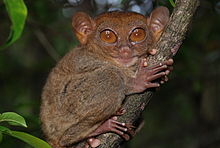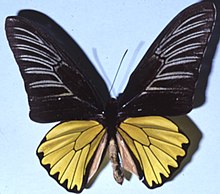Wildlife of the Philippines

The wildlife of the Philippines includes a significant number of endemic plant and animal species. The country's surrounding waters reportedly[1] have the highest level of marine biodiversity in the world. The Philippines is one of the seventeen megadiverse countries and is a global biodiversity hotspot. In 2013, 700 of the country's 52,177 species were listed as threatened.[2]
The Philippines has among the highest rates of species discovery in the world with 16 new species of mammal discovered in the last ten years. Because of this, the degree of endemism in the Philippines has risen and will likely continue to rise.[3]
Some of the smallest and largest animals and plants are found in the Philippines. These include the smallest primate (
Birds


There are 714 species of birds in the Philippines, of which 243 are endemic, three have been introduced by humans, and 52 are rare or accidental occurrences. The Philippines has the third-highest number of endemic birds, behind the much larger countries of Australia and Indonesia. There are 67 globally threatened species, including the rufous hornbill and the critically endangered national bird of the Philippines, the Philippine eagle or monkey-eating eagle. Until 1995, the national bird of the Philippines was the maya (which, in the Philippines, refers to a variety of small, commonly observed passerine bird).[citation needed] The Philippines is also home to Tawi-Tawi's blue-winged racket-tail, the most endangered parrot species in Southeast Asia, the Sulu hornbill, one of the most endangered animals in the world with a population of just 27, and the Calayan rail, the most endangered species of rail in the world, found only on a small island in the Babuyan Islands.[5]
According to the EDGE of Existence Programme of the
Amphibians and reptiles
There are more than 111 species of amphibian and 270 species of reptile in the Philippines, of which 80% and 70% are endemic, respectively.[7] Of the 114 species of snake, it is thought that no more than 14 are venomous. Several species of reptiles and amphibians remains undescribed. The Philippines also has 50–60 endemic Platymantis frog species, making it by far the most diverse genus of amphibians in the archipelago.[8]
The endemic freshwater crocodile
Other threatened reptiles include
Marine animals
Among the seas of the Philippines' 7,107 islands there is great diversity of marine animals. Butanding, or
Freshwater fish
The Philippines has about 330 species of freshwater fish,[10] including nine endemic genera and more than 65 endemic species, many of which are confined to single lakes. An example is Sardinella tawilis, a freshwater sardine found only in Taal Lake. Lake Lanao, in Mindanao, seems to be experiencing the country's most catastrophic extinction event, with nearly all of the lake's endemic fish species now almost certainly extinct, primarily due to the introduction of tilapia for the expansion of the fishing industry. Other exotic species were also introduced to the lake.[3]
Insects and other invertebrates

About 70% of the Philippines' nearly 21,000 recorded insect species are found only in the country. In addition, about one-third of the 915 butterflies found here are endemic to the country, and over 110 of the more than 130 species of

Crustaceans are very diverse in the archipelago. More than 50 species of freshwater crabs (in the genera Carpomon, Insulamon, Isolapotamon, Mainitia, Mindoron, Ovitamon, Parathelphusa, and Sundathelphusa) are known from the Philippines and all are endemic to the country.[11]
Flora
See also
- List of extinct animals of the Philippines
- List of threatened species of the Philippines
- List of non-marine molluscs of the Philippines
- List of endemic birds of the Philippines
- List of mammals of the Philippines
- Environmental issues in the Philippines
- Wildlife of Palawan
References
- ^ Carpenter, K.E. and V.G. Springer. 2005. Environmental Biology of Fishes (2005) 72: 467–480.
- ISBN 978-92-64-26908-8. Retrieved April 20, 2023.
- ^ a b c Conservation International. "Biological diversity in the Philippines". Retrieved March 17, 2015.
- ISBN 9789712314452.
- ^ Allen, Desmond. Birds of the Philippines.
- ^ "Species". EDGE of Existence.
- . Retrieved on April 14, 2017
- ^ Medenilla, Vina (May 19, 2022). "A primer on bangus". Manila Bulletin.
- ^ Nguyen, T.T.T., and S. S. De Silva (2006). Freshwater finfish biodiversity and conservation: an Asian perspective. Biodiversity & Conservation 15(11): 3543–3568
- ISBN 9789004207615.
External links
- "The National Invasive Species Strategy and Action Plan 2016-2026" (PDF). Department of Environment and Natural Resources-Biodiversity Management Bureau. 2016.
